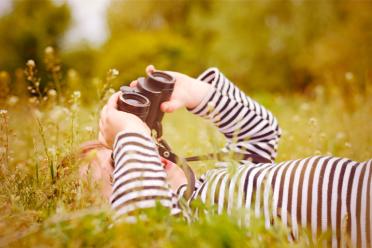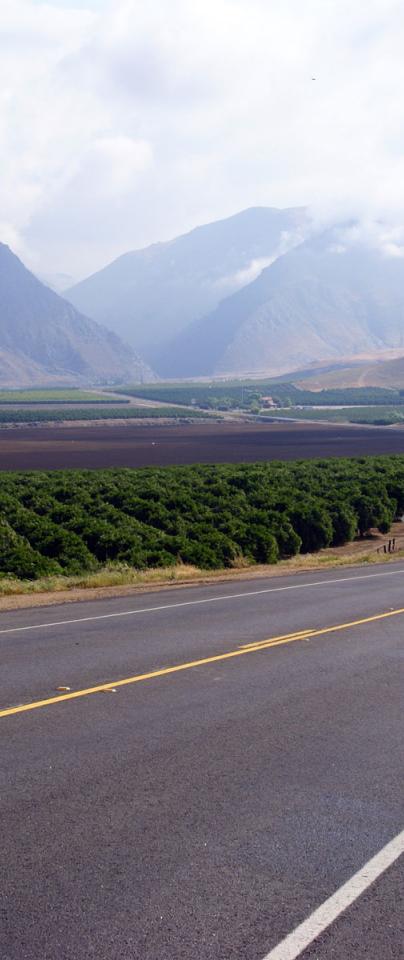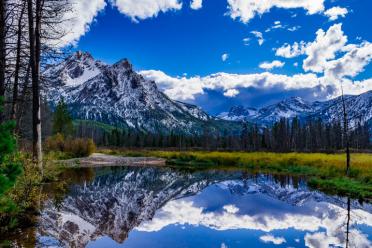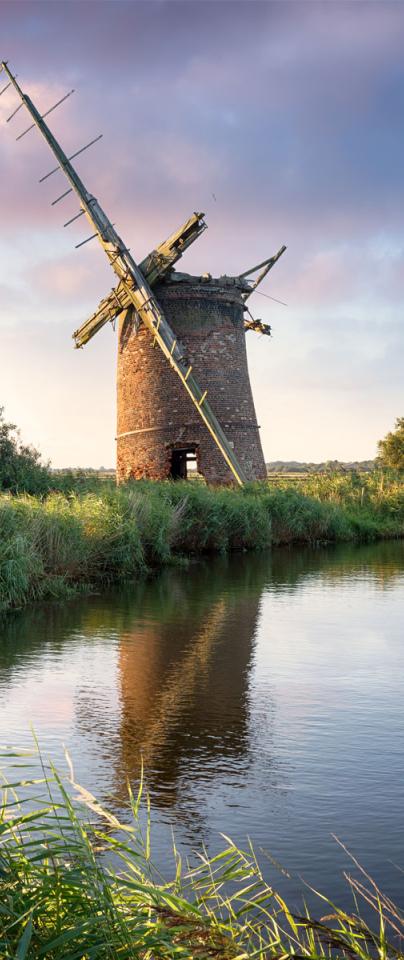Women in Science: Michelle Grey, living the dream
From falling in love with science, to escaping domestic violence, then the journey to EI via MSN messenger: follow Michelle Grey’s inspiring story.
As far as inspiring stories go, this is one to really take heed of. Michelle’s journey is one of a scientist who has battled through terrible setbacks, namely twelve years of domestic violence, to forge a career for herself in a field that she loves.
As a young girl, Michelle would hide under bushes to spy on the fluttering birds she loved to try to understand, holding her hand out from her secret vantage point to see if they would hop on.
From those days, and wanting to be a wizard after watching Fantasia, Michelle has come through some very tough times to ensure that the budding chemist in that five year old girl would, one day, become the wizard she’d always dreamed of becoming.
We asked Michelle to share with us her story, which is an inspiration: especially to those who have suffered through, or are suffering, domestic violence. She has proven how it’s possible to make it through a terrible situation, and to forge a new life despite it, never letting the dream die.
Now at Earlham Institute, Michelle is working with Dr Mark McMullan in the Neil Hall Group, where she is helping us to understand how plants and their pathogens evolve, and how we might better understand the threats to our agriculture using genomics.
I was between 3-5 years old when I was first developing the curiosity into how things work the way they do. How did birds fly? What made their bodies light enough to soar? I tried to fly so many times but only wound up with a cracked wrist in the end.
I did take something far more important away though, and that was how to observe. I would hide out to watch and learned how to keep still enough that a bird would actually land on my hand (that is saying a lot for a preschooler!): by sitting quietly I could observe nature and even get the chance to interact with it from time to time.

My parents were very religious and yet were very much determined that I should have a fair chance at education. They attended all of my teacher/parent conferences and assisted me in getting the class choices I wished to take. Our home environment was very much conducive of studying: lots of quiet spaces, and we were not allowed to have the TV on until our homework was completed.
My grandparents also spurred me on by taking me away to the coast or up in the mountains close by to where I grew up. They would point out the local flora and fauna and teach me their common names and sometimes even the scientific names.
My grandfather shared similar interests to me when he was a child, and gave me the microscope he had used at University - an old brass type with lenses which slid into the eye piece. I would spend a lot of time collecting samples from our local pond, our garden and even in our kitchen, then draw what I saw, feeding that endless desire to know more.
They recognised this and would nearly always purchase science related presents for my subsequent birthdays and Christmas. They were all in attendance for my graduation from High School and I know they would have loved to have gone to my graduation here in the UK.
The first lab experience started when I was 14 years old. The farming company which owned a large chunk of the San Joaquin Valley where I lived had a small laboratory and I was hired on in the summer to process water samples and prepare plant and soil samples for the gas chromatograph.
On Saturdays I tested the amount of extraction fluid left within the oil they pressed from safflower and cotton seeds. I worked summers and weekends all the way through until college.


My grandparents also spurred me on by taking me away to the coast or up in the mountains close by to where I grew up. They would point out the local flora and fauna and teach me their common names and sometimes even the scientific names.

I was given a list of the universities and community colleges in and outside of the state of California which offered the sciences I was most interested in.
California Polytechnic State University (Cal Poly), University California Los Angeles and Massachusetts Institute of Technology (MIT) were high on my list of possibles. I was accepted to all of them but then saw the costs and my heart sank.
I looked at more affordable options and after a long while I decided on attending a 2-year college in the state of Idaho. This would offer the same credits as a four year institution for each year and would directly transfer to the 4-year university once I chose to do so, but cost far less.
So I wound up in Rexburg, Idaho attending Rick’s College and studied cellular biology, chemistry and filled in the rest of the year with classes like environmental geology and health science, to name a few.
A life changing moment occurred at this point. I had met a guy over the winter break who was from Seattle, Washington. He liked the same music and seemed really cool so we started a relationship.
It was a bit of a whirlwind with him living in Seattle and me attending college in Idaho, which is about a 12 hour drive. We only saw each other during breaks and I wound up getting a temporary job just after finals for the first year at a place just outside of Seattle. This meant we could see each other everyday if we wanted.
I then became pregnant and this is when all of my education plans came to a screeching halt.
As I mentioned above, my parents were extremely religious and what I had done was a sin and I was an embarrassment to them. All my Dad wanted was for me to get married before I started showing so that he would save face. I was told that I had two choices.
One was to keep seeing him and live on my own and raise this baby without any support from my parents. They did not want to be a part of that type of low-life. Or, I marry him and we go to church and ask for forgiveness. I was confused and heartbroken to say the least and decided to do what my parents thought best and get married.
I was married on the 27th June 1989 in a blue dress because I didn’t deserve white.
This was not an easy task. I felt like I deserved the way I was being treated for the past 12 years. I mean, I had sinned and now had to ‘sleep in my bed’. Unfortunately this involved three innocent children who were now exposed to and experiencing the same amount of abuse on a regular basis.
When I was 25 I was knocked to the ground. I experienced quite a jolt to the head and following this a few weeks later I experienced a life threatening brain haemorrhage. This was the turning point in my life because I nearly lost it (my life).
Unbeknownst to me I had what is known as a cerebral arteriovenous malformation. The jolt to my head a week or so previous had been enough to disrupt it and it finally haemorrhaged on the 15 February 1996. Subsequently I had to undergo some procedures which made me really take into account how fragile life is. I asked myself what kind of example was I to my children?
It took me 4 years after this to build up enough courage to file for divorce. I started taking night classes once my neurosurgeon gave me the all the clear and I was passing the modules with high marks just like in high school. I also threw in a drawing class for those amoebas or paramecium I might find in some pond water somewhere.
My confidence was increasing day by day. I was told over and over how stupid and worthless I was not only by him but my inner self for those past 12 years.

I hadn’t been allowed to go back to school during my marriage and now I was doing it on my own and I was doing well. Shortly afterwards I found a job at Qiagen Genomics where I found I still was interested in organisms at a molecular level. I also found a network of support in my genomics co-workers, who encouraged me through all of my night classes and tutored me when needed.
I felt included amongst people I could relate to again and I felt clever at times again. My children struggled a bit from the change in circumstances but I remember my oldest saying he was so happy to see me smiling. He had never seen me smile for real.
Qiagen Genomics was a start up company of Qiagen GMBH that actually trialled out their methods and kits. I worked with the creators of the PCR protocol Qiagen still uses today. My managers were very supportive of my educational endeavours, so much so that they made pursuit of my degree in biochemistry a condition to working there.
This combination of studying and doing was the best thing for me as I learn better with the combination of the senses. I was introduced to immunology while working there, which sparked my interest in plant pathology and re-kindled my interest in phytochemistry.
So how did I wind up here in the UK. Well, in 2001 I was chatting with my best girlfriend in the whole world who just so happened to be my Mom via MSN messenger. My Mom loved technology and this new messenger service was just too much fun.
So my Mom and I had a competition on who could get the new emoticons downloaded before each other. This new crying face emoticon had just been released and I was determined to use it in our chat before she did. So we are chatting away and I try it out and the tear is stationary and I’m like, this isn’t working right?
So I download it again as I thought maybe it hadn’t downloaded properly and it comes up with a link to a chatroom and a message saying to try out the new emoticon here. I thought they were being sneaky and luring people into these ‘weirdo-infested’ chat rooms with these new emoticons and took the bait.
The competition was real and I wanted to win!
Long story short, I met this guy named Andrew on there and he just so happened to live in the UK in a county called Norfolk. We met up in person a year later and had this super long-distance relationship going for two years! In the second year he surprised me when he flew over on Valentine’s day and proposed!
We were married a year later in Santa Barbara on my Great Aunt’s estate in May of 2003. In July of 2003 we all moved over to the UK and I have been here since.


Long story short, I met this guy named Andrew on there and he just so happened to live in the UK in a county called Norfolk. We met up in person a year later and had this super long-distance relationship going for two years!

After a few years of adjusting to life in the UK, I was given the opportunity to beef up the particle sizing component in the macrofauna lab of Gardline. I worked in that position for a year and was able to sign a training agreement to go back to school, but this time it needed to be distance learning as they could not afford to let me attend classes during the day. So, I started my Environmental Science degree at Warnborough College in October 2010.
As part of the course I had project management and used my development of the PSA (particle size analysis) lab in my coursework. After completing the module and earning high marks, we moved the lab into larger premises and I put all of my designs and plans into action.
At the end of that first year in the new premises we had doubled the amount of samples being processed and the implementation was considered a success. I was then offered the role of laboratory supervisor and given 16 field scientists to train and utilise as/when required. This experience led me to the job I have here at EI.

It is actually how I imagined working in science would be as a child, working here at the EI. There is a buzz in the air and I feel in my element once again.

Dr Mark McMullan is not only my line manager but I feel like he is also my mentor. He has pursued and accomplished the goals he set out to and is still striving for, as are so many others here.
I feel honoured to be in the Neil Hall group and would like to pursue a PhD through publication while I am here. I am surrounded by brilliance and lapping it up as a fast as I can!
If I had it my way I would finish up my career here.
I am passionate about art. I love poetry, fiction, science fiction, music and oil paintings. I have two published poems and won a blue ribbon in a community art festival back home on one of my oil paintings, so next I would like to dabble in children’s stories and/or guides to the countryside and seaside here in Norfolk.
I had to sketch a lot of sea creatures during the modules involving marine science and was encouraged by my tutor to put together the guide using these and further drawings, so maybe I will try this out. I also have collected and dried several wild plant species of Norfolk and would like to write a short book on these as they all seemed to have some interesting uses back in the olden days.
I believe curiosity is at the root of creativity and creativity is necessary to research. I find myself playing things out in my head before putting them into action and running over things if it doesn’t work out right to then come up with possible solutions.
This has worked for me in the lab and in other pursuits thus far so I will continue to keep my passion for both alive.

My advice for anyone who may find themselves in an unhappy or unhealthy situation would be to first, find someone that you can trust to confide in.

It was the lack of understanding I felt from my friends that kept me feeling too low to do anything about it for so long.
No matter who you are you owe it to yourself and to this funny world of ours to be happy and content. The road is hard and bumpy and full of twists and turns but will be worth it.
I would like to leave you with my favourite poem by Robert Frost:
Two roads diverged in a yellow wood,
And sorry I could not travel both
And be one traveler, long I stood
And looked down one as far as I could
To where it bent in the undergrowth;
Then took the other, as just as fair,
And having perhaps the better claim,
Because it was grassy and wanted wear;
Though as for that the passing there
Had worn them really about the same,
And both that morning equally lay
In leaves no step had trodden black.
Oh, I kept the first for another day!
Yet knowing how way leads on to way,
I doubted if I should ever come back.
I shall be telling this with a sigh
Somewhere ages and ages hence:
Two roads diverged in a wood, and I—
I took the one less traveled by,
And that has made all the difference.